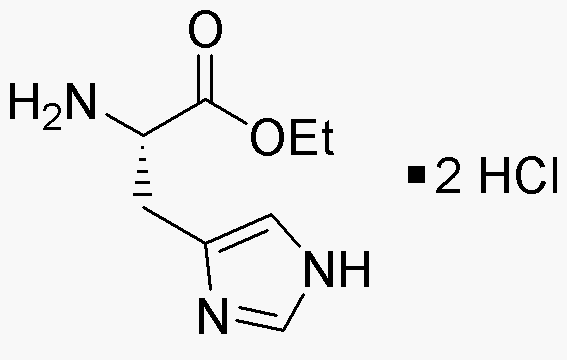L-Histidine ethyl ester dihydrochloride is widely utilized in research focused on:
- Biochemical Research: It serves as a precursor in the synthesis of histidine, an essential amino acid, which is crucial for protein synthesis and enzyme function.
- Pharmaceutical Development: This compound is explored for its potential role in drug formulations, particularly in enhancing the bioavailability of therapeutic agents.
- Nutritional Supplements: It is used in dietary supplements aimed at improving muscle recovery and overall health due to its role in histamine production and immune function.
- Cell Culture Media: The compound is incorporated into cell culture media to support the growth of various cell lines, particularly in studies related to cancer and metabolic diseases.
- Research on Neurotransmission: It is investigated for its effects on neurotransmitter regulation, which may lead to insights into treatments for neurological disorders.
General Information
Properties
Safety and Regulations
Applications
L-Histidine ethyl ester dihydrochloride is widely utilized in research focused on:
- Biochemical Research: It serves as a precursor in the synthesis of histidine, an essential amino acid, which is crucial for protein synthesis and enzyme function.
- Pharmaceutical Development: This compound is explored for its potential role in drug formulations, particularly in enhancing the bioavailability of therapeutic agents.
- Nutritional Supplements: It is used in dietary supplements aimed at improving muscle recovery and overall health due to its role in histamine production and immune function.
- Cell Culture Media: The compound is incorporated into cell culture media to support the growth of various cell lines, particularly in studies related to cancer and metabolic diseases.
- Research on Neurotransmission: It is investigated for its effects on neurotransmitter regulation, which may lead to insights into treatments for neurological disorders.
Documents
Safety Data Sheets (SDS)
The SDS provides comprehensive safety information on handling, storage, and disposal of the product.
Product Specification (PS)
The PS provides a comprehensive breakdown of the product’s properties, including chemical composition, physical state, purity, and storage requirements. It also details acceptable quality ranges and the product's intended applications.
Certificates of Analysis (COA)
Search for Certificates of Analysis (COA) by entering the products Lot Number. Lot and Batch Numbers can be found on a product’s label following the words ‘Lot’ or ‘Batch’.
*Catalog Number
*Lot Number
Certificates Of Origin (COO)
This COO confirms the country where the product was manufactured, and also details the materials and components used in it and whether it is derived from natural, synthetic, or other specific sources. This certificate may be required for customs, trade, and regulatory compliance.
*Catalog Number
*Lot Number
Safety Data Sheets (SDS)
The SDS provides comprehensive safety information on handling, storage, and disposal of the product.
DownloadProduct Specification (PS)
The PS provides a comprehensive breakdown of the product’s properties, including chemical composition, physical state, purity, and storage requirements. It also details acceptable quality ranges and the product's intended applications.
DownloadCertificates of Analysis (COA)
Search for Certificates of Analysis (COA) by entering the products Lot Number. Lot and Batch Numbers can be found on a product’s label following the words ‘Lot’ or ‘Batch’.
*Catalog Number
*Lot Number
Certificates Of Origin (COO)
This COO confirms the country where the product was manufactured, and also details the materials and components used in it and whether it is derived from natural, synthetic, or other specific sources. This certificate may be required for customs, trade, and regulatory compliance.


